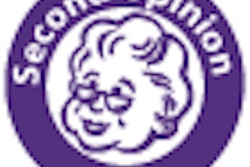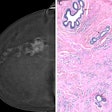LAS VEGAS - The outgoing chair of the U.S. Preventive Services Task Force (USPSTF) defended the group's controversial 2009 revision of mammography screening guidelines in a speech at this week's National Consortium of Breast Centers (NCBC) annual meeting.
Dr. Ned Calonge said that the USPSTF's decision to remove its long-standing recommendation that women ages 40 to 49 receive mammography screening was based on "cold, hard science." He offered a crowd of skeptical NCBC attendees a behind-the-scenes look at the process the task force used to revise the guidelines as part of a joint NCBC session on Sunday that also included Dr. Jay Parikh, past president of the NCBC and current head of imaging at Swedish Medical Center in Seattle.
"Our recommendation is evidence-based," Calonge said regarding the 2009 guidance. "When we developed the guideline, there were no patients involved, no passions involved -- just the numbers and the harms and benefits [of the exam] as registered in the literature."
At the same time, however, Calonge acknowledged that the task force could have done a better job of communicating the new guidelines. He said the USPSTF has revised its guidance development process to generate more involvement from the public and the scientific community.
Sparking a controversy
Calonge was chief medical officer of the Colorado Department of Public Health and was the state epidemiologist when he was tapped to chair the USPSTF in 2004. In 2010 he left state government to become president and CEO of the Colorado Trust, a foundation dedicated to improving access to healthcare in Colorado. His term as USPSTF chair ended on Friday.
The USPSTF sparked controversy in November 2009 when the panel rescinded its 2002 recommendation that women ages 40 to 49 receive regular mammography screening. The USPSTF said that existing literature did not support the use of routine screening in this age group -- a finding that has been disputed by a number of medical societies and women's healthcare groups -- and gave the procedure a grade of C, meaning that it carries small net benefit and should not be used routinely.
Calonge said that the task force's new recommendation was actually very similar to a 2007 guideline published by the American College of Physicians in the Annals of Internal Medicine (April 2007, Vol. 146:7, pp. 511-515). And the USPSTF's 2009 guidance was never intended to prevent women in this age group from having screening mammography, much less influence insurance coverage decisions.
"When we voted on this recommendation in 2008, there was no President Obama, no healthcare reform," Calonge said. "If our recommendation had come out shortly after we voted, would the reception have been different? Perhaps. We were the wrong group ... at the wrong time."
Practicing the process
To shed light on how the task force reached its decision, Calonge explained the process behind the development of guidelines. When it develops recommendations, the task force does the following:
- Defines the question about the provision of a service or intervention
- Retrieves evidence about that service
- Judges the quality of the evidence and its adequacy for addressing the key question(s)
- Synthesizes the judged evidence
- Judges the certainty of net benefit: high, moderate, or low
- Gives the service/procedure a letter grade
"If we have an outcome [that we make public], we've used our process protocol," Calonge said.
Procedures that carry high certainty and substantial net benefit are graded "A." Procedures with moderate certainty and moderate net benefit are graded "B." A and B grades mean that the USPSTF recommends the use of the procedure.
If there is at least moderate certainty but small net benefit, the procedure is graded "C," and the task force recommends against routine use. If a procedure carries no net benefit and does more harm than good, it is graded "D," and the USPSTF recommends against its use. A procedure categorized as "I" means that more research needs to be done: It does not mean that the intervention is ineffective but, rather, that there is no current evidence for effectiveness.
"We spent a year talking to physicians about the language for the C grade," Calonge said of the screening mammography guidance. "A, B, and D grades are automatic. But for procedures with a C grade, you have to be a clinician, tailor your services to the patient, practice prevention. You have to think."
Hard to improve on asymptomatic
The Holy Grail of early detection is early treatment that actually changes outcomes for the better, Calonge said. But if medicine is going to reach out to asymptomatic people, it should only do so when there are strong indications of net benefits for a test or procedure. And the data for reduced mortality rates from screening mammography for women ages 40 to 49 are just not compelling, according to Calonge: A 15% mortality reduction is as good as mammography gets for women younger than 50.
"Out of eight randomized, controlled trials that have included more than 450,000 women around the world, not a single one has ever by itself shown a statistically significant reduction in mortality for women ages 40 to 49," he said. "Deaths from breast cancer in this age group are so small that it's difficult to conduct a single study with enough participants."
Calonge reviewed the task force's thinking on the harms of mammography screening, including pain, anxiety, distress, risk of false positives or false negatives, additional imaging, unnecessary biopsies, and radiation exposure.
"Every time 1,000 women between the ages of 40 and 49 are screened, there will be one false negative and almost 100 false positives that the clinician then has to do something else with," Calonge said. "The screening round will generate at least nine biopsies that will detect about two cancers and less than one [ductal carcinoma in situ]."
Calonge emphasized, however, that what the USPSTF is recommending is that women in this age group talk to their physicians about whether to undergo regular mammograms.
"We based our recommendation on a consistent application of our methods, without concerns for cost, coverage, or advocacy," Calonge said. "Screening mammography for women between the age of 40 and 49 should not be automatic, but should include a discussion between the woman and her primary caregiver."
It's a free country
It's amazing how two different scientific bodies can come to completely different conclusions using the same data, the NCBC's Parikh said in his part of the session.
"But this is America, and everyone is entitled to an opinion," he said.
According to American Cancer Society statistics, women between the ages of 40 and 49 have a one in eight cumulative lifetime risk of breast cancer. And 40% of all years lost to breast cancer are in women in this age range, Parikh said.
In its systematic review, the USPSTF failed to consider all available evidence of mammography's benefits, Parikh told session attendees. He restated the NCBC's response to the USPSTF's guidelines.
"In every country starting population screening, mortality declines coincide with onset of screening, not systemic therapy," he said. "The USPSTF models are not based on sound data, namely different denominators in the harms versus benefits groups leading to invalid comparisons. Recent data from randomized, controlled trials reveal significant mortality reductions evident approximately five years after screening programs were initiated. The reductions in age-adjusted, disease-specific mortality -- 30% to 40% since 1990 -- define screening program benefits not seen in the prior six decades."
The USPSTF did not include input from scientific or clinical experts in its process, Parikh said -- a charge Calonge denied. It also conducted closed sessions, with no opportunity for the public or for experts to comment, and the task force's report and supportive analyses for the recommendation were embargoed until its release, Parikh said.
As for the harms of screening mammography, they are trivial or temporary in the greater scheme of things, according to Parikh. Quality of life, not just survival, has significant value, and it has been well established that if mammography for women in their 40s is discontinued, cancers eventually detected will be larger, more likely to need more aggressive surgery, more likely to need chemotherapy, and more likely to lead to other significant socioeconomic concerns.
The NCBC does not understand the assumptions used by the USPSTF to value human life, Parikh said.
"One statistic equals one woman, and to her, she's not a statistic," he said.
While defending the USPSTF's decision-making process, Calonge said the group could have done a better job by getting the scientific community and the public more involved. In the future, the USPSTF is posting its recommendations on its website for expert and public comment, Calonge said.
"The timing of our [2009] recommendation was unfortunate, and we communicated poorly," he said. "Going forward, every recommendation is now posted on our website for public and expert comment, and we take those comments seriously."




















